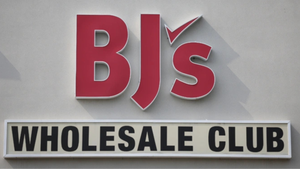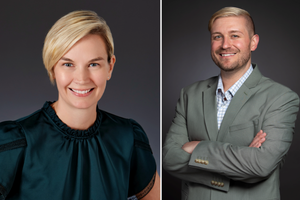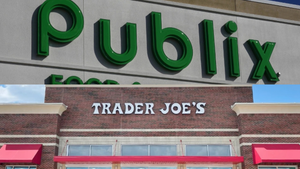HAIR THERAPY OFFERS HBC THICKER DOLLAR SALESHAIR THERAPY OFFERS HBC THICKER DOLLAR SALES
A proliferation of hair-growth products, hair-thickening shampoos and shampoos with frizz control is offering supermarkets higher dollar sales potential in the therapeutic hair category.Supermarkets need to create a section for hair-therapy shampoos, said Bill Swartz, senior vice president with MAI-Alper, a broker in Framingham, Mass. These products are gaining at retail, he said.Shampoos with frizz
May 5, 1997
PETER MALBIN
A proliferation of hair-growth products, hair-thickening shampoos and shampoos with frizz control is offering supermarkets higher dollar sales potential in the therapeutic hair category.
Supermarkets need to create a section for hair-therapy shampoos, said Bill Swartz, senior vice president with MAI-Alper, a broker in Framingham, Mass. These products are gaining at retail, he said.
Shampoos with frizz control are doing extremely well, according to Swartz. "The anti-frizz category is one of the hotter trends in shampoo," he said.
One company, Advanced Research Laboratories, based in Costa Mesa, Calif., has introduced what it says is the first unisex line of hair products for the mass market that treats fine, thinning or limp hair. The "Thicker Fuller Hair" line consists of 10 stockkeeping units. A 12-ounce shampoo is available at a suggested retail price of $4.99.
Manufacturers like ARL are also capitalizing on the growing trend toward over-the-counter anti-frizz products. ARL's 12-ounce Zero Frizz Hydrating Shampoo is available at an SRP of $4.99.
These products are available at leading supermarket chains such as Albertson's, Boise, Idaho; Vons, Arcadia, Calif; Ralphs Grocery Co., Compton, Calif.; Kroger Co., Cincinnati; and Winn-Dixie Stores, Jacksonville, Fla.
Intensive conditioners with therapies are also becoming more popular than the traditional hair conditioners, he said. "There's a new product coming from Alberto-Culver called Cortexx. It mends damaged hair through the roots, providing thicker hair."
Another segment that is escalating is hair growth. Swartz said there are now enough hair-growth products on the market to create a subsegment in the shampoo aisle. "Supermarkets can do a better job of merchandising and promoting those items to get a better share of the category."
The hair-growth category has taken off in the past year, Swartz said. The leading product in the hair-growth category, Rogaine, has done pretty well, he noted. "But I don't think it has met expectations in the food class of trade. Part of it is the expense, and part of it is the way it is being merchandised. A lot of places still have it behind the counter. It is an inhibitor to purchase the product."
There's been some reluctance on the part of retailers to place these high-ticket items on the supermarket shelf, not to mention the reluctance on the consumer's part to spend anywhere from $15 to $40 for hair-regrowth items in a food store.
"When you go to the supermarket, you have a certain amount of money you have to spend to put food on the table for a week," commented Bud Milliken, vice president of sales for OTC products at Pharmacia & Upjohn, Kalamazoo, Mich.
"Supercenter supermarkets that have conditioned their customers that they are one-stop food-and-drug stores are performing better on those products. It is getting advertised, but supermarkets could do a better job of saying to their customers that it is available here and it is priced competitively," the executive continued.
"We think the hair-growth segment should be next to therapeutic shampoos. That is where we are trying to put the product. The shampoo shopper is shopping in food," Milliken stated.
Rogaine for men and women moved to OTC April 3, 1996. Rogaine was approved as a prescription product for men in 1988 and for women in 1991.
Bausch & Lomb's Healthguard minoxidil brand and Alpharma's Barre products were introduced in May 1996 soon after a Kalamazoo, Mich., federal court ruling of April 30 that year, upholding the Food and Drug Administration's April 5 decision to deny three-year marketing exclusivity to Rogaine.
Meanwhile, the FDA has just cleared Minoxodil Topical Solution 2%. Its marketer, Morton Grove Pharmaceuticals, Morton Grove, Ill., said the FDA approval letter pronounced Minoxodil to be "therapeutically bioequivalent" to Rogaine.
Hair-growth products racked up $155 million worth of sales for the 52-week period ending March 2, 1997, according to statistics from Information Resources Inc., Chicago. Rogaine has cornered a market share of 76% in this category, with $118 million in sales.
Private-label hair-growth products placed second, earning $28 million and 18.6% of the market share. Teva, Copley and Perrigo market private-label Rogaine equivalents. Private label is followed by Bausch & Lomb's Healthguard brand minoxidil product, with $5 million in sales and 3.3% of the dollar share, and Alpharma's Barre product, with $1.9 million in sales and 1.2% of the dollar share.
Some supermarkets, like Ray's Food Place, Brookings, Ore., have decided not to sell hair-growth products at all.
"We made a decision not to carry those products. Pilferage is the major issue," said Dan Van Zant, director of health and beauty care and general merchandise. He said the decision was based on several factors: the high-ticket retail, the amount of inventory the chain would need to invest and the relatively slow turns.
"It was a corporate decision. We didn't have a lot of confidence in the antitheft technology. It is certainly a deterrent but it would not stop the pilferage problem.
"Quite frankly, we have not received any complaints from any customers to date. I don't believe we would be the destination shopping point for an item like that. Is it really worth tying up the space? We probably made the right decision. We're not seeing the sales in some of our competitor stores such as Albertson's and Safeway. The feedback that I am getting from the brokerage community is that sales are not that strong," Van Zant said.
Ingles Markets, Black Mountain, N.C., has taken a different approach. "We have it in 62 of our stores," said Tony Federico, vice president of nonfood. "We built a special merchandising rack at the front-end registers for very expensive OTC products such as smoking cessation and Rogaine. We lock it up at all times. We are very cautious about theft."
About 70% of Rogaine's volume is coming from drug accounts, with food and mass merchandisers running neck-and-neck, with about 15% of volume. "Drug is doing marvelously with it. They were far more aggressive in getting the product out," Milliken said.
Of the mass accounts, Kmart did quite well with Rogaine, Milliken said, but Wal-Mart was the least aggressive. "Wal-Mart is just now moving the product on the shelf. They had it at the pharmacy counter."
Rogaine is available in single, twin or triple units. The single-unit Rogaine SKU has greater distribution in food stores than the twin.
At retail the single 2-ounce Rogaine averages $29, which is one month's supply, Milliken said. The twin averages $50 and the triple $70. Pricing across classes of trade does not vary dramatically, Milliken noted.
Rogaine for men sells better than the women's product, but the gap is narrowing slowly, Federico said. On average, Ingles sells a piece per week per store. "That's awfully good when you look at profitability. It's quite a good return on investment."
Margins on Rogaine are consistent with the HBC category, ranging from 25% to 35%, but it is off a considerably higher dollar, pointed out Swartz, the broker. "Sell one product like that and the penny product is high."
"The men's single Rogaine is the No. 1 SKU in hair care, based on annual sales. It's pretty significant," said Milliken of Pharmacia & Upjohn. More than 5 million people have used the hair regrowth treatment to date, according to the manufacturer. Users must apply Rogaine to a clean, dry scalp twice a day.
According to clinical research done by Pharmacia & Upjohn, 26% of men who use Rogaine report moderate to dense hair regrowth, while 33% say they had minimal hair regrowth. As for female users, 19% experienced moderate hair regrowth, and 40% said hair regrowth was minimal.
Sales of female Rogaine are about one-third of total Rogaine sales. "It's been growing quite dramatically. It's the same product in a different box," Milliken said.
Milliken said men are far more aware of men's Rogaine than women are of Rogaine for women. "The men's prescription product was approved first. Men are more aware of balding as a natural condition. Women, on the other hand, need more information to understand that thinning hair is correctable," he said.
"There is a tendency for women not to talk about it. Women have a tendency to think there is something far greater wrong with them if their hair is thinning. With women, they go through quite a traumatic experience when they lose their hair."
Securing Rogaine Sales
Rogaine manufacturer, Pharmacia & Upjohn, Kalamazoo, Mich., wants retailers who are concerned about theft to know they can order Rogaine with either the Checkpoint or Sensormatic theft-deterrent scanning technology.
"We were the first manufacturer to offer both technologies. We wanted to make sure the potential for pilferage was being addressed. All of our displays are theft-resistant," said Bud Milliken, vice president of sales for over-the-counter products.
Checkpoint and Sensormatic are deactivated at checkout. "We sell product with tags or without tags. But some accounts don't have the technology. The store has to have the technology," he said.
To boost sales of Rogaine in supermarkets, Pharmacia & Upjohn offered a $15 in-ad retailer rebate program in April. In June participating supermarkets will offer a buy-one, get-one-free promotion for Rogaine singles, Milliken said.
Food stores taking part in the Rogaine promotion include: Stop & Shop Cos., Spartan Stores, Pathmark Stores, Safeway, Grand Union Co., Wegmans Food Markets, Supervalu, Schnuck Markets, Kroger Co., Cub Foods, Piggly Wiggly, Save Mart Supermarkets, Kings Super Markets, Albertson's, Ralphs Grocery Co. and Vons Cos., "We had a huge event in January, called the starter-kit event. Consumers were able to buy a four-month supply for the price of two. [For optimal results it must be used for four months.] Consumers received four months' supply for the price of two. Drug and mass got a tremendous promotional lift from that," Milliken said.
"Supermarkets are not taking advantage of the opportunity as much as they could, in many cases because of the hesitancy to put the product in the shampoo section," Milliken commented.
Smaller food accounts are stocking Rogaine at the customer-service counter, which is impeding sales, Milliken said.
"There is still an embarrassment factor. Consumers are hesitant to draw attention to their thinning hair by asking for the product," the executive observed.
The consumer needs to understand the product is in the store, Milliken said. "Food [stores] have to do a lot more promotion to alert the customer. Using the Rogaine shelf organizer is important -- it is designed to be theft-resistant. People can only take one product off at a time."
Milliken said the food class of trade understands that it needs to do better in optimizing prescription-to-OTC switches.
"It's important food [stores] find a way to deal with higher-priced items. They will concede the growth area of health and beauty care, and prescription-to-OTC switches."
About the Author
You May Also Like




